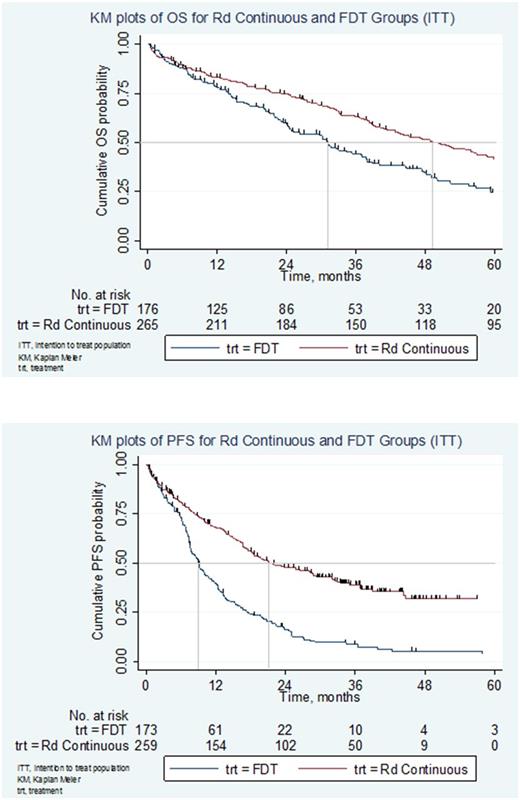Abstract
BACKGROUND
Continuous therapy for patients with transplant-ineligible (TNE) newly diagnosed multiple myeloma (NDMM) is an emerging treatment concept, based on the results of the FIRST trial (MM-020). In the United Kingdom, the current standard of care for patients with TNE NDMM is based on fixed-duration therapy (FDT) for the first 2 lines, primarily consisting of 6-8 cycles of either a bortezomib (BOR) or thalidomide (THAL) combination. We performed case matching with the continuous lenalidomide and dexamethasone (Rd continuous) arm of the FIRST trial and compared the associated clinical outcomes with FDT in a real-world setting.
METHODS
TNE patients treated in the real-world setting between 2009 and 2017 within Thames Valley Cancer Network (United Kingdom) were eligible to be included. Patient data from the real-world setting were matched by age cohorts and International Staging System (ISS) stage to patient-level data for Rd continuous from study MM-020. Data from 176 patients who received FDT in the real-world setting are presented here. The primary outcome measure was overall survival (OS), calculated as time from initiation of frontline treatment to death from any cause. Secondary endpoints included progression-free survival (PFS) and time to next treatment (TTNT). Treatment-free interval (TFI) was also explored in the FDT real-world group. Differences between Rd continuous and real-world FDT were tested using an unstratified log-rank test. The median OS and Cox hazard ratios, with 95% confidence intervals (CIs), were calculated and Kaplan-Meier survival estimates are presented.
RESULTS
The combined data set comprised 442 TNE NDMM patients (Rd continuous, n = 266; FDT, n = 176). Patient characteristics were comparable between the 2 groups: male (Rd continuous, 58%; FDT, 60%), > 75 years (Rd continuous, 49.6%; FDT, 49.4%), ISS I/II (Rd continuous, 40.6%; FDT, 40.9%), ISS III (Rd continuous, 59.4%; FDT, 59.1%). FDT first-line therapy comprised proteasome inhibitor-based (23%), thalidomide-based (59%), lenalidomide-based (8%), and alkylator-based (10%) therapy. Rd continuous showed significantly improved OS compared with FDT (50.37 vs 31.11 months; HR = 0.65 [95% CI, 0.51-0.83]), PFS (21.85 vs 9.10 months; HR = 0.418 [95% CI, 0.33-0.53]), and TTNT (39.52 vs 18.3 months; HR = 0.41 [95% CI, 0.32-0.54]). The longest TFI during FDT was following first-line therapy (median, 7 months [IQR, 1.4-18.1 months]), decreasing to 2.4 months after second-line therapy (IQR, 0.8-6.3 months).
CONCLUSIONS
This large, matched-cohort comparison of real-world TNE patients receiving FDT compared with continuous upfront Rd therapy confirms that Rd therapy provides significant benefit in terms of OS, PFS, and TTNT. In this comparison, the OS associated with Rd continuous was improved by over 19 months compared with FDT consisting of predominantly BOR or THAL combinations. This analysis also demonstrates that in the FDT cohort, the TFI is short after first-line therapy and decreases further with subsequent treatment. This analysis provides comparative evidence with real world-data and supports Rd continuous therapy as a new standard of care for patients with TNE MM.
Djebbari: Takeda: Honoraria; Celgene: Honoraria, Other: Educational Grant.. Lynes: Celgene: Employment, Equity Ownership, Other: educational grant awarded to Oxford Haematology Department. McLain-Smith: Celgene: Consultancy. Ramasamy: Amgen: Honoraria; Takeda: Honoraria, Research Funding; Janssen: Honoraria.
Author notes
Asterisk with author names denotes non-ASH members.


